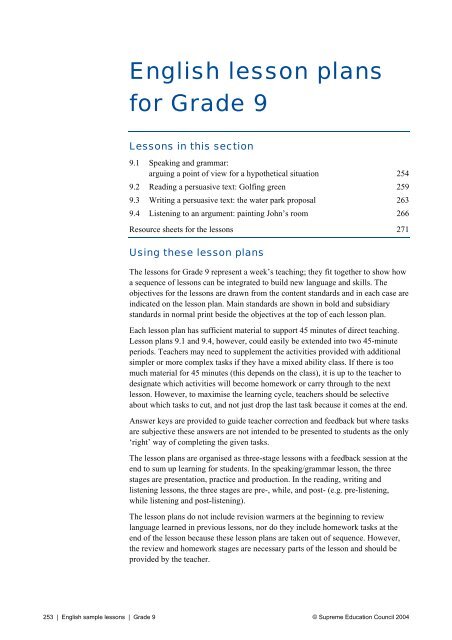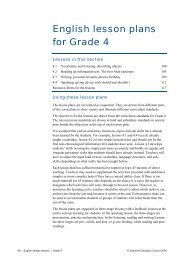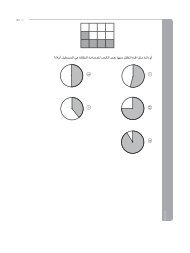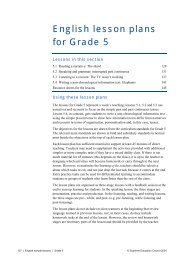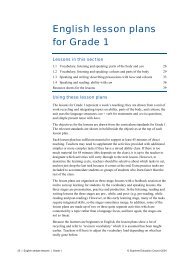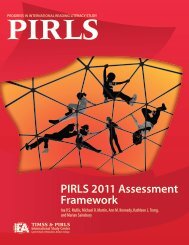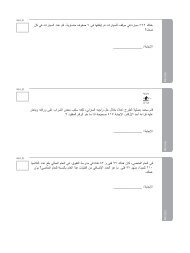English lesson plans for Grade 9
English lesson plans for Grade 9
English lesson plans for Grade 9
- No tags were found...
You also want an ePaper? Increase the reach of your titles
YUMPU automatically turns print PDFs into web optimized ePapers that Google loves.
<strong>English</strong> <strong>lesson</strong> <strong>plans</strong><strong>for</strong> <strong>Grade</strong> 9Lessons in this section9.1 Speaking and grammar:arguing a point of view <strong>for</strong> a hypothetical situation 2549.2 Reading a persuasive text: Golfing green 2599.3 Writing a persuasive text: the water park proposal 2639.4 Listening to an argument: painting John’s room 266Resource sheets <strong>for</strong> the <strong>lesson</strong>s 271Using these <strong>lesson</strong> <strong>plans</strong>The <strong>lesson</strong>s <strong>for</strong> <strong>Grade</strong> 9 represent a week’s teaching; they fit together to show howa sequence of <strong>lesson</strong>s can be integrated to build new language and skills. Theobjectives <strong>for</strong> the <strong>lesson</strong>s are drawn from the content standards and in each case areindicated on the <strong>lesson</strong> plan. Main standards are shown in bold and subsidiarystandards in normal print beside the objectives at the top of each <strong>lesson</strong> plan.Each <strong>lesson</strong> plan has sufficient material to support 45 minutes of direct teaching.Lesson <strong>plans</strong> 9.1 and 9.4, however, could easily be extended into two 45-minuteperiods. Teachers may need to supplement the activities provided with additionalsimpler or more complex tasks if they have a mixed ability class. If there is toomuch material <strong>for</strong> 45 minutes (this depends on the class), it is up to the teacher todesignate which activities will become homework or carry through to the next<strong>lesson</strong>. However, to maximise the learning cycle, teachers should be selectiveabout which tasks to cut, and not just drop the last task because it comes at the end.Answer keys are provided to guide teacher correction and feedback but where tasksare subjective these answers are not intended to be presented to students as the only‘right’ way of completing the given tasks.The <strong>lesson</strong> <strong>plans</strong> are organised as three-stage <strong>lesson</strong>s with a feedback session at theend to sum up learning <strong>for</strong> students. In the speaking/grammar <strong>lesson</strong>, the threestages are presentation, practice and production. In the reading, writing andlistening <strong>lesson</strong>s, the three stages are pre-, while, and post- (e.g. pre-listening,while listening and post-listening).The <strong>lesson</strong> <strong>plans</strong> do not include revision warmers at the beginning to reviewlanguage learned in previous <strong>lesson</strong>s, nor do they include homework tasks at theend of the <strong>lesson</strong> because these <strong>lesson</strong> <strong>plans</strong> are taken out of sequence. However,the review and homework stages are necessary parts of the <strong>lesson</strong> and should beprovided by the teacher.253 | <strong>English</strong> sample <strong>lesson</strong>s | <strong>Grade</strong> 9 © Supreme Education Council 2004
9.1Speaking and grammar:arguing a point of view <strong>for</strong>a hypothetical situationObjectives<strong>Grade</strong> 9 curriculumstandards 5.5, 5.2, 4.3,4.4, 4.5PresentationResourcesOHT 9.1aVocabulary(to) go bankrupt(to) close down(to) threaten(to) thrivesavings• Use the second conditional in positive and negative statements to discusshypothetical future proposals and their consequences.• Present and argue a point of view to convince others.Set the sceneShow the class the headlines on OHT 9.1a. Make sure students understand whateach one means and use them to discuss with students why, as countries develop,populations move from the countryside to the big cities. Elicit from students thefollowing sequence of events, orally, using the simple word cues on the left.PresentationWord cueno moneyno farmsno shops,cinemas, cafesno jobs andnothing to dono young peopleno savingsno visits homeno help <strong>for</strong>the oldno communityno village lifeStudents sayFarming doesn’t bring in enough money.Because there isn’t enough money, the farms go bankrupt.Because the farms go bankrupt, the local shops, cinemas, and cafesclose down. (There aren’t enough customers.)Because the shops, cinemas and cafes close down, there are no jobsand there’s nothing to do.Because there are no jobs and nothing to do, the young people leavethe village and go to the big city.Because the city is expensive (they’re no longer living at home),young people have no savings.Because they have no savings, they don’t go back home to the villageto visit their families.Because they don’t visit, there’s no help or support <strong>for</strong> the old people.Because there’s no support <strong>for</strong> the old, the community breaks up.Because there’s no community, village life disappears.Get students to go through the cause-and-result sequence in pairs as an oral drill.They can take it in turns to run through the sequence or do it by question andanswer, starting at the end and tracing the causes back.Why is there no village life? Because there’s no community.Why is there no community? Because there’s no help <strong>for</strong> the old people.Etc.Model sentencesElicit positive and negative sentences with the second conditional through thequestions below. Get students to practise saying the sentences aloud, correctpronunciation and then write the model sentences on the board.254 | <strong>English</strong> sample <strong>lesson</strong>s | <strong>Grade</strong> 9 © Supreme Education Council 2004
Example questions: What if it became a tourist area? Would there be moremoney? (Yes)Model sentence:Example question:Model sentence:If it became a tourist area, there’d be more money.If there were jobs would young people still leave? (No)Young people wouldn’t leave if there were jobs.Get students to copy the model sentences into their exercise books.PracticeResourcesTeacher’s resource 9.1aConcept checkElicit/check students understand the meaning/use, <strong>for</strong>m and pronunciation of thesecond conditional, used here <strong>for</strong> hypothetical situations in the future, with thequestions below. This is not the first time they’ve seen the second conditional, soconcept checking should be quick.• Are we talking about the future or the past? The future• Does the verb after if look like a past tense verb? Yes But is it? No• Are we talking about something that exists or something we wish <strong>for</strong> orhope <strong>for</strong> in the future? Something we wish <strong>for</strong> or hope <strong>for</strong> in the future• What’s the other type of if sentence you know? First conditional / If +present + will future• Which sentence is more real, more likely to happen: ‘If there are jobsyoung people will stay’ or ‘If there were jobs, young people would stay’?The first sentence• So when do we use this second type of conditional? When things are unlikely/ unreal / wished <strong>for</strong> / hypothetical future• What’s this construction called? The second conditional• How do we make it? If + [past <strong>for</strong>m] + would / wouldn’t• Can we use might instead of would? Yes How about could? Yes Can we usecould in the if’ clause too? Yes Give me an example with ‘if / borrow /money / turn their farm into a guest house’. If they could borrow the money,they’d turn their farm into a guest house.• Do we have to start the sentence with the if clause? No• Show me an example we’ve already got. Young people wouldn’t leave ifthere were new jobs <strong>for</strong> them.• ‘They would turn their farm into a guest house’ or ‘They’d turn theirfarm into a guest house?’ Where’s the stress, on ‘would’ or on ‘turn’? (onthe modal verb or the main verb?) On ‘turn’/on the main verb.Word cue drillUse the word cues on the board to create a chain of second conditional sentences.Practise as a whole class and then in pairs.Word cueno moneyno farmsStudents sayIf there were more money, the farms wouldn’t gobankrupt.If the farms didn’t go bankrupt, the farmers would usethe shops, cinemas and cafes more.255 | <strong>English</strong> sample <strong>lesson</strong>s | <strong>Grade</strong> 9 © Supreme Education Council 2004
no shops, cinemas,cafesno jobs and nothingto dono young peopleIf the shops, cinemas and cafes had more customers,there’d be more jobs and there’d be something to doin the evenings.If there were more jobs and there was something to doin the evenings, the young people wouldn’t all leave.If the young people didn’t all leave … etc.Chain gameEncourage students, working in their pairs, to come up with more hypotheticalcauses and results generated from this scenario. Elicit a few examples.• What would happen if they opened a water park near the village?There’d be a lot of new jobs.There might be a water shortage.There wouldn’t be enough water <strong>for</strong> the farmers.They could sell their land to the water park company.Etc.Put students in groups of four or five and get them to sit in a circle. Give eachgroup a set of question cards (prepared from teacher’s resource 9.1a). The firststudent in each group turns over a question card and answers it with a full secondconditional sentence.Card 1What would happen if thewater park used up all thewater?A: If the water park used up all the water a lotof wild life would die.The second student takes the would clause, turns it into an if clause and makes anew sentence. The third student in the circle trans<strong>for</strong>ms the new sentence in thesame way, and the chain continues until the idea and its hypothetical consequencesare exhausted. Then the group turns over a new card and the process is repeated,starting with the second student.Card 1What would happen if thewater park used up all thewater?A: If the water park used up all the water a lotof wild life would die.B: If a lot of wildlife died, it wouldn’t be asbeautiful as be<strong>for</strong>e.C: If it wasn’t as beautiful as be<strong>for</strong>e, touristsmight stop coming.D: If tourists stopped coming, the water parkwould go bankrupt.Etc.256 | <strong>English</strong> sample <strong>lesson</strong>s | <strong>Grade</strong> 9 © Supreme Education Council 2004
Card 2What would happen if thefarmers didn’t want to selltheir land to the water parkdevelopers?B: If the farmers didn’t want to sell, thedevelopers would go somewhere else.C: If the developers went somewhere else theyoung people would followEtc.ProductionResourcesOHTs 9.1b, 9.1cTeacher’s resource 9.1bFeedbackMonitor and correct <strong>for</strong> accuracy. Input ideas into the chain if any of the groups orindividuals within the group seem stuck.RoleplayUsing OHTs 9.1b and 9.1c, tell the class that they are preparing <strong>for</strong> a villagemeeting to decide whether they want a water park to be built in their village or not.Some of them think it’s a good idea, some disagree, and some are not sure. Giveout role cards (prepared from teacher’s resource 9.1b) and get students toindividually think about their role and prepare what they are going to say. Putstudents with the same roles in pairs or small groups and get them to share ideasand work together to build up as many things to say as possible to support theirposition. Then get them to practise presenting their point of view to each other,using a variety of arguments and examples. When they are ready, put students intogroups of ten, so that each of the ten roles is represented in each group. Get theMayor to chair the meeting. Get the developer to begin by presenting the plan <strong>for</strong>the proposed water park. Remind them to use their second conditionals. Ensureeach student expresses his or her point of view clearly, according to role, arguesthe case and tries hard to persuade the group. Encourage other villagers to agree ordisagree, and question ideas, using known structures. Monitor <strong>for</strong> clarity ofargument, ability to defend a position, ability to speak at length as well as <strong>for</strong>accuracy. Note examples of good ideas and common errors to use <strong>for</strong> the feedbacksession without interrupting the flow of the roleplay. Use the roleplaydiagnostically to note down how much further practice students need in expressinga point of view, using persuasive language, and speaking strategies <strong>for</strong> groupdiscussions. When everyone has had their say, get each group to vote <strong>for</strong> or againstthe water park proposal.Find out how many of the classroom villages voted to build a water park and howmany voted against and get them to say why. Use your record of good ideas toelicit from individual students specific arguments. Deal with the most commonspoken errors orally.257 | <strong>English</strong> sample <strong>lesson</strong>s | <strong>Grade</strong> 9 © Supreme Education Council 2004
Summary <strong>for</strong> studentsIf + past + would is used to express ideas in the unreal or hypothetical future. Youhave been discussing arguments <strong>for</strong> and against building an imaginary water park.In reality, it doesn’t exist but you have been imagining what consequences such aproject would bring.You have also been practising how to express your point of view in public. Someof you sounded more convincing than others because your arguments were wellprepared. You said clearly at the beginning what your point of view was. You gavetwo or three reasons to support your point of view.This week, we’re going to continue to learn how to express an opinion or a point ofview and how to persuade others when we’re speaking and when we’re writing.We’re also going to continue practising our first and second conditionals.258 | <strong>English</strong> sample <strong>lesson</strong>s | <strong>Grade</strong> 9 © Supreme Education Council 2004
9.2Reading a persuasive text:Golfing greenObjectives<strong>Grade</strong> 9 curriculumstandards 7.6, 7.1, 5.5Pre-readingResourcesInternet picturesWorksheet 9.2aVocabularyecologyeco-groupsa building booma shortagea rubbish tip• Read and analyse a persuasive text.• Distinguish fact from opinion.Set the sceneUse a picture of Tiger Woods (from any image archive on the Internet – e.g. YahooImages, or via Google) or anyone playing golf to introduce the topic of golf andhow all over the world people are building golf courses. Talk about environmentversus golf tourism and link the discussion to the previous <strong>lesson</strong> on village versuswater park. Pre-teach the vocabulary, relating the new words to the topic.Open predictionElicit one or two ideas from the whole class about what the negative effects ofbuilding golf courses might be. Write one of their examples on the board.It uses up too much land.While readingResourcesWorksheet 9.2bGet students to copy it. If they want to say, ‘It’s bad <strong>for</strong> the environment’, tell themthis is too general – they have to predict specifically how it’s bad <strong>for</strong> theenvironment. Get students to write their own list of three negative effects that theythink will be mentioned in the text they are about to read. Put students into groupsof four and get them to share ideas and build a larger list from their individual lists.Then hand out worksheet 9.2a and get them to quickly read it and check off whichof their predictions were correct.Comprehension exercisesHand out worksheet 9.2b. Get students to find examples from the text to supportthe dangers of golf and the benefits of golf (exercise ‘Reading <strong>for</strong> the main ideas’).Tell them to summarise each example and write it in note <strong>for</strong>m in the table. Getthem to fill in the line number in the text where the example came from.Answer keyReading <strong>for</strong> the main ideasThe dangers of golf Line The benefits of golf Linefish die 4 it’s very popular 8–9trees are cut down 5–6, 26 it covers up rubbish tips 21it uses too much water; it createswater shortagesit uses up good farmland (farmerslose their jobs)golf courses are built in nationalparks/<strong>for</strong>ests3, 13 wildlife returns 231516hills are moved 25chemicals and pollutants are used 27259 | <strong>English</strong> sample <strong>lesson</strong>s | <strong>Grade</strong> 9 © Supreme Education Council 2004
Check students’ answers through monitoring, not in front of the whole class.Get students to read the text another time and then do the remaining exercises onworksheet 9.2b. Have students work individually and then compare/discuss theiranswers with a partner. Monitor and guide students towards the right answers bypointing to specific parts of the text. Get them to reference their own answers fromthe text in this way too, quoting specific line numbers where possible. Correctanswers through monitoring, not in front of the whole class.Answer keyReading <strong>for</strong> facts1 Developed: The USA, Spain (Japan, Britain)Developing: The Philippines, Indonesia2 Clint Eastwood – actor, a politicianTiger Woods – professional golferSusan Arnold – environmentalistDon Brinklow – journalistReading between the lines1 Golf has become fashionable because Tiger Woods is young and fun to watch, sothousands of people now want to play golf – be<strong>for</strong>e it was a game only <strong>for</strong> the old andrich.2 It’s almost a desert so even more water is needed to keep the grass alive.3 They’re rare trees.4 It brings money and jobs. It’s a short-term solution.5 Because it’s cheap; because their own country is too overcrowded.Working out the meaning of words from context1 (Line 4) highlights – shows clearly2 (Line 8) hotting up – getting more and more important3 (Line 14) points out – explains4 (Line 15) thrown off – made to leave5 (Line 15) to make way <strong>for</strong> – allow to go aheadDistinguishing fact from opinionStatement Fact Opinion Not clearThe government is closing Paul Allen’s golf course. The fish died because Paul Allen used up too much oftheir water.Clint Eastwood has <strong>plans</strong> to cut down trees on his land.Tourism is always more important than the environmentin poor countries.If something is a problem in developed countries, it willbe an even greater problem in developing countries.Golf courses need millions of gallons of water to waterthe grass.The Japanese, businessmen and politicians cause theproblems.Golf courses are good <strong>for</strong> the environment.Golf courses are built on rubbish tips.Sum up these exercises in front of the whole class by pointing out any commonmisunderstandings, problems or omissions only.260 | <strong>English</strong> sample <strong>lesson</strong>s | <strong>Grade</strong> 9 © Supreme Education Council 2004
Text analysisGet students to complete the exercise ‘Analysing text organisation’ on worksheet9.2b in pairs, discussing their answers and ideas in <strong>English</strong> or Arabic. Then put theclass into plenary. Use an enlarged version of the text on an OHT to check answerswith the whole class. As you go through the questions and answers, build up ananalysis of the text organisation and draw out the features of a persuasive text.Label the paragraphs and examples ‘<strong>for</strong>’ and ‘against’, underline opening andclosing statements, and persuasive language. Use the answer key below to helpyou.Answer key1Paragraph Dangers of golf Benefits of golf1 2 3 4 title ?Post-readingResourcesWorksheet 9.2b2 3 benefits; 7 dangers.3 Opening: News last week … highlights golf’s environmental dangers.Closing: And that green is only managed with the help of pollutants and chemicals.They make the same point so that the writer’s opinion is clear. Repetition emphasisesand persuades.4 The opening paragraph proposes the point of view, the closing paragraph repeats thatpoint of view <strong>for</strong> emphasis. The middle paragraphs give the arguments <strong>for</strong> and against.The ‘<strong>for</strong>’ and ‘against’ examples are both mentioned but not balanced because theaudience has to be persuaded to choose one rather than the other.5 It might look too opinionated and put readers off. The slightly unclear <strong>for</strong>-or-againstfeeling because of the question mark and the play with words (‘green’ as in golf course,‘green’ as in environmentally friendly) entice and persuade the reader to read on.6 (a) ‘News last week …’, use of the present perfect <strong>for</strong> things that have just happened,use of the present continuous <strong>for</strong> things that are happening now;(b) ‘Clint Eastwood is battling …’, ‘… hotting up’, ‘Imagine then …’,‘… thrown off perfectly good farmland …’, ‘what was once … is now the playground ofbusinessmen and politicians’.7 The title (see above), talking about famous people such as Clint Eastwood and TigerWoods, the idea that this problem is close to home – not just in South East Asia – thearticle is written <strong>for</strong> Europeans and Americans: it starts with what’s happening inAmerica and says ‘Even in places like Spain …’Further practice: second conditionalGet students to look at the sentence stubs in the exercise ‘Grammar practice’ onworksheet 9.2b. Elicit a few completed sentences from the whole class.If Paul Allen preferred fishing to golf, there wouldn’t be a water problem / thefish would survive / he’d still be killing fish.If Tiger Woods weren’t so popular, there wouldn’t be a golf course buildingboom…Put students into pairs and have them hypothesise on the rest of the sentence stubs.This is a speaking exercise; they don’t have to write anything down – although261 | <strong>English</strong> sample <strong>lesson</strong>s | <strong>Grade</strong> 9 © Supreme Education Council 2004
Feedbackwriting out their ideas could be set <strong>for</strong> homework or follow up. Remind them touse their second conditionals because it’s an ‘unreal’ future. Monitor and correct<strong>for</strong> accuracy.Ask students if they were persuaded that golf is a danger to the environment. Getthem to give you their reasons why or why not.Summary <strong>for</strong> studentsIn the <strong>lesson</strong> about the water park development, you practised expressing a point ofview and you had a go at persuading your friends to agree with it. In this <strong>lesson</strong>,we’ve read a persuasive text about why golf is dangerous <strong>for</strong> the environment.We’ve looked at some of the features of a persuasive text. They are:• an opening statement which states the writers point of view and a closingstatement that rein<strong>for</strong>ces it;• a logical argument supported by a series of examples;• the opposing point of view expressed but in a way that it is criticised orweakened;• a lot of statements which are opinion rather than fact, but enough facts to makethe argument believable.You have seen persuasive texts in advertisements be<strong>for</strong>e. Persuasive texts, like thisone, are also written about current events and controversial issues. Somepersuasive texts are stronger than others – the language of persuasion inadvertisements is usually stronger than in journalistic articles. This one is not verystrong because it is more journalistic – the writer is selling an idea rather than aproduct so the message is not as direct as in an advertisement.Unless you’re motivated by the topic, you won’t get involved. The text uses certainlanguage to ‘hook’ you – in this case playing with words in the title, using tenses<strong>for</strong> immediacy, quoting famous people, using dramatic language, bringing the issue‘home to the reader’.In the next <strong>lesson</strong>, we’re going to have a go at writing our own persuasive texts.262 | <strong>English</strong> sample <strong>lesson</strong>s | <strong>Grade</strong> 9 © Supreme Education Council 2004
9.3Writing a persuasive text:the water park proposalObjectives<strong>Grade</strong> 9 curriculumstandards 9.4, 5.5Pre-writingResourcesWorksheet 9.3aOHT 9.3a• Write a persuasive letter from notes.• Link ideas with suitable connectives.• Use second conditionals in context.NetworkAs a continuation of the two previous <strong>lesson</strong>s, introduce the proposal that somewater park developers want to build a new water park near the school. In pairs, getstudents to brainstorm advantages and disadvantages of this. Have students refer tothe last two <strong>lesson</strong>s <strong>for</strong> ideas. Put a network like the one below on the board andget students to share their ideas and write them as notes on the board.EnvironmentJobslifeguards, waiters, salesassistants, office jobsGood• covers rubbish tips• new trees, parks, grass• wild life increasesShould weallow a waterpark?Bad• water shortages• people lose their land• old buildings destroyed• chemicals and pollutantsyoungpeoplestayCulture• inappropriate• only <strong>for</strong> touristsGuided writingTell students they are going to write a letter to their urban development council,supporting the idea of building a water park near the school. Their job is topersuade the councillors to build the park. Elicit from them the features of apersuasive text:• it should have an opening statement expressing the writer’s point of view;• there should be two or three arguments with evidence or examples to supportthe point of view;• a common objection should be stated but then refuted;• the conclusion should rein<strong>for</strong>ce the point of view in the opening statement.Hand out worksheet 9.3a and get students to recognise the features of a persuasivetext through the category headings in the table. During steps 1–5 below, monitor,263 | <strong>English</strong> sample <strong>lesson</strong>s | <strong>Grade</strong> 9 © Supreme Education Council 2004
point out errors, provide new vocabulary and get students to self correct andredraft.1 Fill in the opening statementElicit an opening statement to the letter that says students support the water park.Refine the statement and write it on the board. Get students to copy it into thetable.We support the plan to build a new water park near our school because it wouldprovide jobs and be good <strong>for</strong> the environment.2 Fill in column one (Notes)Get students to choose from the network three supporting ideas and one objection.Get them to copy the notes or key phrases from the board into the left-hand columnof worksheet 9.3a. Elicit suggestions <strong>for</strong> a counter-argument <strong>for</strong> the objection andget them to fill in the counter-objection box in the left-hand column.Use salt water from the sea3 Fill in column two (Second conditional statements)Divide the class into groups of eight and subdivide the eight into four sets of pairs.Assign each pair to work on one idea <strong>for</strong> the letter. (Objection and counterobjectioncount as one idea.) Get pairs to trans<strong>for</strong>m the notes into secondconditional statements and write their sentences in the middle column of the table.If we allowed the water park to be built, it would provide jobs <strong>for</strong> young peopleand stop them from leaving the area.If it were built on top of the rubbish tip, it would make good use of that land.4 Fill in column three (Examples, evidence or result)Get students to add an example, evidence or result to their statement and fill intheir section of the third column.As well as jobs in building the water park, there would be jobs <strong>for</strong> lifeguards,sales assistants, waiters and administration staff.This has been done be<strong>for</strong>e with building golf courses in the UK and the USA.5 Share sentences and fill in the conclusionPut students into groups of four with one representative of each idea in each group.Get them to dictate their sentences to each other and complete the whole table.Have them decide on the order the ideas should be presented in the letter. Get themto brainstorm a conclusion.We should go ahead with the <strong>plans</strong>. The whole community will benefit.Show students OHT 9.3a and get students to compare or improve their own fromit.264 | <strong>English</strong> sample <strong>lesson</strong>s | <strong>Grade</strong> 9 © Supreme Education Council 2004
While writingResourcesWorksheet 9.3bWriting frameTell students they are now ready to write their persuasive letter to the head of theUrban Development Council. Hand out worksheet 9.3b. Get students to look at theskeleton letter and identify which phrases which:• introduce the opening statement and the conclusion;• link the three ideas in favour of the water park;• introduce the objection and link the counter objection to it.Working individually, get students to transfer their sentences from their writingplan in worksheet 9.3a to the context of a letter using the writing frame inworksheet 9.3b.Post-writingResourcesOHT 9.3bFeedbackMonitor <strong>for</strong> accuracy and provide any vocabulary, or sentence structures asnecessary.Get students to swap letters and peer-correct.Further practice / optional activityShow students the letter on OHT 9.3b. Point out the underlined words where youhave refined the sentences with better vocabulary or <strong>for</strong>mal written constructions.Get students to improve their letters from it.Get students to go through the whole process again, this time to write a letterpersuading the Urban Development Council not to build the water park. Tellstudents to complete the letter <strong>for</strong> homework and hand it in to you on an agreeddate.Summary <strong>for</strong> studentsPlan your writing the way we have done <strong>for</strong> this letter. Organise your ideas andexamples in a logical way. Use a network and an in<strong>for</strong>mation table like the ones weused.Use link words like in addition, moreover, however, to connect one idea to thenext. Use I feel, I believe, It is my belief that in persuasive texts to personalise thepoint of view and make it stronger. Use it or this to refer to the main issue insteadof repeating ‘water park’ all the time.Use a writing frame like the one we used or copy the <strong>for</strong>mat from an authenticletter, along with the opening and closing phrases. Then just trans<strong>for</strong>m the contentto say what you want to say. This is how all good writers learn to write well.265 | <strong>English</strong> sample <strong>lesson</strong>s | <strong>Grade</strong> 9 © Supreme Education Council 2004
9.4Listening to an argument:painting John’s roomObjectives<strong>Grade</strong> 9 curriculumstandards 3.1, 3.2, 3.3,5.2, 5.3Pre-listeningResourcesWorksheet 9.4aTape or tape script 9.4Vocabulary(to) decorate / redecorate(to) do (it) up(to) see (it) throughinterior designtaste (in) …style• Listen and understand two people arguing; one trying to persuade, the other notbeing convinced.• Follow and summarise a point of view.• Use arguments gathered to persuade others.Set the sceneIntroduce the situation. Tell students they’re going to listen to a conversationbetween a boy called John and his mother. John is 16 and wants to paint his room.His mother doesn’t want him to. She has a lot of objections. John uses counterargumentsto try to persuade her.Pre-teach the vocabulary.True/false statement predictionBe<strong>for</strong>e listening, get students to look at the statements in exercise 1 on worksheet9.4a and choose three of them that they think are true. Get students to comparetheir choices with a partner and encourage disagreement so that it gives them apurpose <strong>for</strong> listening.Then get them to listen to the conversation on the tape 9.4 and see who chosecorrectly.Answer keyStatementJohn has never painted his room be<strong>for</strong>e.John wants to borrow money from his mother to paint his room.John wants to paint the room orange.At the moment, he doesn’t spend a lot of time in the room.His mother doesn’t believe he’ll finish the job.John doesn’t have very good taste.In the end John manages to persuade his mother.True?WhilelisteningResourcesWorksheet 9.4aOrderingGet students to go through the vocabulary in exercise 2 on worksheet 9.4a,checking that they remember all the words, teaching each other or clarifying withyou any they don’t remember. Some of the words are introduced in this <strong>lesson</strong>,others are words they’ve studied be<strong>for</strong>e, from the <strong>Grade</strong> 9 recommended word listor other <strong>lesson</strong>s. Get students to listen to the conversation again, this timerecognising the key words and phrases. Tell them to number the words in the list inexercise 2 in the order that they hear them. Get them to compare their answers witha partner. If there’s some disagreement, get them to listen to the tape again.266 | <strong>English</strong> sample <strong>lesson</strong>s | <strong>Grade</strong> 9 © Supreme Education Council 2004
Answer keyVocabulary Order Order(to) jump to conclusions 8 (to) neglect something 2(to) bring (something) about 1 interior design 6(to) see (something) through 12 personal style 5(to) go <strong>for</strong> (something) 9 a rubbish tip 4(to) decorate 3 talent 11(to) spill (e.g. the paint) 10 appropriate colours 7PyramidGet students to recall the main ideas or themes behind the arguments John uses topersuade his mother and the objections she uses. Have them work individually,then share ideas in pairs. Get them to check their list by looking at the middlecolumn (Topic) of the table in exercise 3, worksheet 9.4a. Get them to listen to theconversation a third time but now working in pairs with A listening <strong>for</strong> Mum’sobjections, and B listening <strong>for</strong> John’s arguments. Get students to summarise eachargument or objection, picking out key phrases and writing notes in the appropriatecolumns in the table (A fills in the left-hand column, B fills in the right-handcolumn). They work individually, then in pairs and then groups, rememberingdetails and building up their in<strong>for</strong>mation from what others have remembered andwritten in the table. Let them listen to tape 9.4 one more time to check answers andfill in any missing in<strong>for</strong>mation.Answer keyProposal: John would like to redecorate his room in the summer holidaysMum’s objections Topic John’s arguments/point of viewIt’s too expensive. Money I’ll pay <strong>for</strong> it from my own savings.Materials from the hardware store arecheap.You never clean your room. Neglect It’s not my personal style so I don’tcare about it. If it were my design I’dkeep it clean.You’re not good at interiordesign. Your taste changes allthe time. You’ll paint it orange.You don’t spend any time in yourroom anyway.You won’t finish it or you’ll spillpaint everywhere. I’ll have to doit.StyleInterestCare,CompletionThat’s not true. I’ve done a schoolproject on it and I have good taste inclothes. … I won’t paint it orange. I’llpaint it in appropriate colours likeblack and white.If it looked nice I’d spend more timethere.I’ll see it through. I’ll use the time inthe summer holidays.267 | <strong>English</strong> sample <strong>lesson</strong>s | <strong>Grade</strong> 9 © Supreme Education Council 2004
Post-listeningResourcesWorksheets 9.4a, 9.4bFeedbackOral presentation of a persuasive argumentGet students to use the notes they’ve made <strong>for</strong> John in worksheet 9.4a exercise 3to prepare a persuasive speech, as if they were John. Elicit the structure they used<strong>for</strong> their persuasive letters in Lesson 9.3. Hand out worksheet 9.4b and get them toidentify the same features in this speaking frame: the opening statement, the logicalsequence of arguments supported with examples or evidence or a result, anticipatedobjections which are then refuted and a re-expression of their point of view in aclosing statement. Ask the following eliciting questions to emphasise the languagethey should use.• Which phrases directly address the listener with you? Why?• Which phrases use the imperative? Why is the imperative used?• Which phrases capture the listener’s attention?• Which phrases anticipate the listener’s objections?• Which phrases and connectives link ideas?Get students to fill in the speaking frame with notes only. Don’t let them writewhole sentences or their speech will simply become a reading-aloud exercise andthey will loose any sense of directness or persuasion. Get them to rehearse theirpresentations aloud in small groups, taking it in turns to be John. Listeners can useMum’s arguments to prompt speakers when they falter.What about the cost?How can I be sure you’ll finish off the job properly?Monitor, make suggestions, take notes of the most common errors but don’tinterrupt the flow of the presentations.Get students to self and peer-correct the most common errors.Summary <strong>for</strong> studentsThis week we’ve been looking at both spoken and written persuasive texts. You’veanalysed and practised the structure of these texts. Today, you used some of thelanguage features of spoken persuasive texts:• using the imperative and you to address the audience directly;• anticipating the listener’s objections and building these into your argumentwith phrases like be<strong>for</strong>e you say anything, let me explain, you may think, don’tjump to any conclusions, don’t worry that;• using connectives such as now, at the moment, as you know, so, finally.You need more practice in producing persuasive texts. Your next assignment willbe to write a letter to your own parents, persuading them to give you permission toredecorate your bedroom, turning the speaking frame into a writing frame.268 | <strong>English</strong> sample <strong>lesson</strong>s | <strong>Grade</strong> 9 © Supreme Education Council 2004
Tape script9.4John:Mum:John:Mum:John:Mum:John:Mum:John:Mum:John:Mum:John:Mum:John:Mum:John:Mum:John:Mum:John:Mum?What is it, son?You know you said we’re not going away this summer? Well, Iwas thinking …I’m listening. Go on.Well, I was thinking I could use the time to redecorate my room.You know, paint the walls and stuff.Redecorate your room? But that will cost a <strong>for</strong>tune!No it won’t, Mum. I can buy the paint and stuff from the hardwarestore. They usually have a sale on there. It won’t come to much.Fine <strong>for</strong> you but who’s going to pick up the bill?Well, I’ve been saving money from my paper-round job. I’m sure Ihave enough.What’s brought all this about anyway? You’ve always totallyneglected your room – you never clean it – why the sudden need todecorate it now?I think it’s never been the way I want it to be – that’s why I’venever looked after it be<strong>for</strong>e. It’s all from you – your colours, yourchoice of furniture, your taste. I want it to be me. If you let me doit up my way, I’ll want to keep it clean and tidy, you’ll see.That’s what you say now, but I know you. It’ll look like a rubbishtip in no time!Honestly Mum, I’ll keep it tidy – just give me a chance to expressmy own taste and personal style.Huh! So now you’re an interior designer, are you? I don’t see yougetting good marks <strong>for</strong> your art and design classes.Mum, that’s not fair. I’ve always been interested in interior design.Remember that school project I did on ‘Icons of twentieth-centurydesign’? Even Dad thought that was good. And you’ve always saidI have great taste in the clothes I buy.But your taste changes all the time! I can’t let you go and paint theceilings and walls orange, just because it’s the ‘in’ colour this year.When you redecorate, you really have to use neutral shades. Youhave to choose appropriate colours because you’re going to have tolive with those colours <strong>for</strong> a long time.No-one said I was going to paint it bright orange, Mum. That’s justyou jumping to conclusions again. I know the colours should blendin. I was going to go <strong>for</strong> black and white actually.Why go to all that trouble to make it look nice when you neverspend any time in your room anyway?Maybe if it did look nice I’d want to spend more time there. Maybeif I really thought it was my room …No, John. It’s just going to be way too expensive and having spentall that money you’ll give up half-way. I know you!Mum!269 | <strong>English</strong> sample <strong>lesson</strong>s | <strong>Grade</strong> 9 © Supreme Education Council 2004
Mum:John:Mum:John:Mum:John:Mum:That’s right. You’ll get bored. Or you’ll spill paint all over thefurniture. Painting’s an art. It takes talent as well as practice, and italways takes much longer than you think. I can see it now. I’ll bethe one who ends up doing all the work! I just don’t have the timeor the energy <strong>for</strong> this right now.That’s not fair Mum. I wouldn’t ask you unless I was prepared tosee it through. Like I said, I’ll pay <strong>for</strong> it with my own money andof course I’ll finish it off properly. Look! I’ve got all that sparetime in the holidays to do it in, especially if we’re not going awayanywhere. You won’t have to do a thing. You’ll see!No, John.Mum!I said ‘No’!But why Mum?Because I say so!270 | <strong>English</strong> sample <strong>lesson</strong>s | <strong>Grade</strong> 9 © Supreme Education Council 2004


